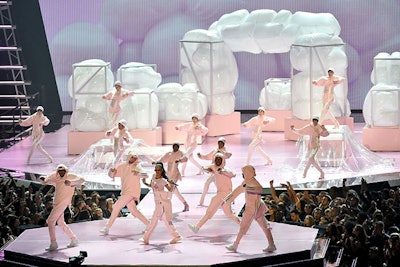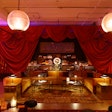
For the first time in the show's 33-year history, the 2016 MTV Video Music Awards took place in New York's Madison Square Garden. Building up to the ceremony on Sunday, the hype of the show included the network's plans to let Kanye West give an unrehearsed speech, Britney Spears' comeback performance, and Rihanna receiving the Video Vanguard Award. Event producers from across the country discussed these moments of the Sunday-night telecast, as well as other aspects they liked and disliked about the show including the integration of social media, a satellite performance by Nick Jonas, and the LED-focused stage design.
David Bassiri
What I liked: The set and stage design. It was clean and simple, intimate and impressive. Acts that used it well—or worked with it—stood out for me, including Future, Beyoncé, and Rihanna’s second and third performances. While the show got itself a bit back on track midway through, the highlight of the entire show was Beyoncé’s performance. It was the tightest production and performance of the evening. It was as if all the money and rehearsal time went to that one segment. Lastly, I loved how they handled Kanye’s speech. It was tense. It was unscripted. They turned down the lights and put you in the audience, looking at Kanye thinking, ‘What in the world is he going to say?’ and he didn’t disappoint.
What I would have done differently: The opening lacked the excitement needed to kick the show off. The first performance was completely flat, and even the camera work felt ad hoc and unplanned. And Key and Peele’s personas just weren’t funny. The awards themselves (which I know is not really the point of the show) felt irrelevant enough to make you ask, ‘Why are we even giving out these awards anyway? Can’t we just get back to the show?’ And there was too much Rihanna. Is there really not enough talent out there to put together a more diverse show? I understand she received the Vanguard award, but the programming could have still been more representative of the music out there.
What surprised me: I was told this was going to be Britney’s comeback. This involved bad lip syncing, bad choreography, and back to the loose production from the beginning of the show. They made her follow Beyoncé?
What I forgot to do: Play a drinking game based on Kim Kardashian cutaways.
Letter grade: D
Bassiri is the vice president and executive producer at Jack Morton Worldwide, a global brand experience agency. Clients have included Google, Marriott, Samsung, and Nike.
Toni Short
What I liked: I love the way the sports and music worlds became closer by integrating the Olympians into the programming. It was very touching to see the young female gymnastics team present Beyoncé with her award—no doubt an inspirational moment for them and a special one for the very humble Beyoncé. This section was topped off with the comedic talents of Jimmy Fallon coming onstage as Ryan Lochte—a true ‘OMG’ moment for Michael Phelps. Bringing in the magic of Madison Square Garden, the stage set felt on point with the large 360-degree screen re-creating a boxing arena or ‘in the round’ atmosphere. The graphics felt grand and very fitting—perhaps a nod to all things that have come before the 2016 V.M.A.s in this historic venue (across all the genres music/sport/entertainment). I also enjoyed the way the camera work featured a lot of shots from above the stage, which really helped tell the story for the viewers at home. Especially with the Beyoncé performance as the Lemonade video is so visual and theatrical. The production team definitely reinvented this beautifully in a live setting with their great overhead camera work. The biggest takeaway for me was something Drake said in his speech to Rihanna: "She succeeds by doing something that no one in this music industry does, which is being herself." Words the world could definitely live by right now.
What felt new: What felt new and very timely was the strong lean toward mostly female performers. From Alicia Keys marking the anniversary of Martin Luther King Jr.’s "I Have a Dream" speech with her poetic tribute, to Rihanna’s multiple high-energy and commanding performances (especially the one that happened in and around the audience seats), and all the way to Beyoncé’s dramatic rendition of her hit Lemonade. The thread even flowed through into the presenters welcoming other notable female music and sport stars like Serena Williams and Mary J. Blige to the stage.
What I would have done differently: While the idea of throwing to Nick Jonas in the diner was great, the live performance seemed a little forced or over-rehearsed and, as much as we all love the Fat Jewish guy, possibly a little bit of over-saturation on that angle. With that said, the camera shot at the end with the Empire State Building behind Nick was another great way of tying in the Big Apple and all its glory to the 2016 V.M.A.s in New York.
What surprised me: It’s a tie for what surprised me most: the producers giving Kanye West carte blanche to speak or Kanye’s eloquent speech. There were some strong positive messages that we can all take from his words, whether you love or loathe him. We’re here to have fun. He and his peers play the role of being the undeniable thought leaders of today. Take stock and value in your role models and don’t compare yourself to anyone.
What felt like a missed opportunity: I can’t pinpoint exactly what was missing but the combination of microphone issues, disjointed choreography, and nothing really new or different in her performance meant that sadly, the Britney Spears performance felt very flat. With all the hype that came with her return to the show after 10 years, this was definitely a missed opportunity.
Letter grade: B+
Short is the founder and C.E.O. of Shortlist Agency, a New York-based event production company. Clients have included Syfy, Godiva, and BBC.
Eddie Ricard
What I liked: This was a tricky year to judge. Every positive moment seemed to be answered with a less than optimal one. It would be unfair to lump the overall production into one category this year—there was such a stark contrast between the long list of incredibly awkward broadcast moments and the solid production that we saw featured on stage.
First, I loved the scenic design. Not only was the cage-like design a smart practical choice to allow for set changes in the otherwise exposed surround of Madison Square Garden—the scenery allowed for many dramatic reveals and acted as an unobtrusive backdrop to the evening’s presenters. I especially loved the use of the sleek white LED lines that accentuated the geometric angles found throughout the stage design. The simplicity of these lines in the tunnel entrance, the floor, and up to the stage backdrop allowed for a sense of cohesion, and were also customizable enough to cater to each performing artist’s unique aesthetic. The LED glitch effect that kicked off Future’s performance is a great example of how the simple, pointed design allowed for very powerful moments of contrast and energy. The clean look of the stage was also echoed in the nominee video graphics, which were very strong and well-paced. Lighting and stage design aside, for awhile it felt like we were limping along—even after Phelps and Kanye. In constant search of a moment destined to become viral, we finally arrived at Beyoncé’s beyond-mega performance, which not only stole the show but, in my opinion, saved it. The production of her performance left nothing on the table. It was beautiful and artful storytelling at its best.
I also have to throw the production team respect for their fun creativity in getting Nick Jonas from the Tick Tock Diner to a live performance on the Pepsi stage outside. Nick’s entrance to the stage followed by an expansive, sweeping camera shot of Madison Square Garden in the background was a memorable moment, and felt much tighter than some of the happenings going on inside the arena.
Some missteps: As I have already hinted above, the show had many moments that were a bit difficult to watch. After Rihanna’s first song, she started to drop her mic down to her side while her full voice continued to come through on the backing track. Although I did appreciate hearing some of her classic hits, the blatant lack of singing, or even lip-syncing, felt sloppy and kicked off an evening full of weirdly abrupt transitions, some poor vocal performances, and a general sense of unease. After Rihanna, it felt like we returned to the pre-show coverage all over again. There was no arrival, no momentum into the next performance, and the theme of bouncing around until someone decided to go on stage, just kept happening. Throughout the show, the transitions from host desk, to backstage, to hype booth, continued to be awkward, rushed, and seemingly unnecessary. I’m all for off-the-cuff commentary, but this just felt like a mess. Beyond the flow of the broadcast, the house felt a bit too bright for most of the show. It wasn’t until Kanye that we were reminded of how impactful a tight spotlight in the vast space of Madison Square Garden can be. I also couldn’t help but notice how empty the audience felt around the runway. At several points in different artist performances, it almost looked like the audience was already clearing out. Part of the reason for having a live show is to capture the excitement and interaction of a crowd. Having performers walk by areas of empty space with only a few surprised audience members looking up from below felt like a missed opportunity, exposing one of the many examples of how the show, except for a few exceptional performances, stayed on the uncomfortable verge of awkward.
Letter grade: B
Ricard is an account executive at Ray Bloch Productions, a New York-based event company that counts NBC Universal, The New York Times, and Activision Blizzard among its clients.
Matt Stoelt
What I liked: Raising the bar once again this year, the overall set design was dynamic and made great use of the space at Madison Square Garden. The ever-challenging "arena" format is tough to differentiate based on the logistics of a show of this nature. The producers did an excellent job of rethinking the set that not only provided a versatile backdrop for all of the performances but also possessed massive scale and audience integration that broke the mold of the typical audience pens. The circular, elevated runway that transitioned into a tunnel created depth and versatility from a production standpoint, while elevating the experience for those both in the audience and the viewers at home watching on television.
Another high point of this year's show was the depth and scale of the performances. All too often, big shows such as these with large budgets seem to fill the stage and ceiling with hundreds of moving lights and LED tiles, only to be underutilized with a lack of programming and content. This year, all of the performances were refined and simple but engaging though the use of digital media, lighting, and strong design. While Beyoncé’s performance transcended several layers of sophisticated sets both on and off the stage, my favorites this year were Rihanna’s second and third performances. For the second performance, the stage was set with old incandescent par cans creating a look of the old New York nightclub, and the stage was brimming with dancers on risers, reminiscent of the scene from the Palladium, pre-Giuliani. The third performance had a set that was straightforward and featured an LED, color-controlled lighting bolt that was suspended from the truss to the stage deck, anchored by a large LED wall playing abstract content in deep, saturated colors. Lastly, I think that it was great to have members of the U.S. Olympic team incorporated into the show. This is, of course, a chance for producers to connect with broader audience and leverage some fantastic role models for the younger generation.
What I didn’t like: By far, the hardest thing to watch this year was the social media hosts situated in a sports reporter-like desk format, ranting what to tweet about and their personas in the social media world. While I understand the importance and need for social reach and exposure, this component detracted from a lot of the improvements from a show standpoint. Second to that was the once-again-expected open mic moment for Kanye West. I understood the need to provide that moment last year for the video Vanguard award. This year, I failed to understand why we once again had more than seven minutes of Kanye’s comments before the world premiere of a new video project. Also, the much-expected ‘satellite’ performance by Nick Jonas lacked tremendously from those of years past, and it was almost awkward watching him make his way through the cafe to the semi-trailer-based stage that looked like an afterthought in comparison to Katy Perry at the Brooklyn Bridge.
Much like last year, on the technical production side of things, the stage lighting looked like it was incredible for fans at the venue, however the television lighting was almost non-existent. For the better part of most of the show, the lighting was blown-out, and viewers at home didn't get to experience nearly as much as they could have. For Beyoncé and Rihanna’s final performance, the problem seemed to vanish altogether, and there was sufficient key lighting on both the talent and the scenic components. On the audio front, this vastly improved from last year, and there was only a brief moment of issues near the end of the show during the Beyoncé performance where the levels peaked and distorted on the broadcast mix for viewers at home.
Letter grade: B-
Stoelt is the C.E.O. and creative director of Stoelt Productions, a Los Angeles-based experiential marketing agency and event production company. Clients include Pandora, Dior, Billboard, and M.A.C.
Chris Weinberg
What I liked: I absolutely loved DJ Khaled’s pre-show energy. He resonates with today's youth and keeps it real with his interviews and shout-outs. Beyoncé and Rihanna stole the show. Beyonce's performance, although lengthy, woke up the show as only Queen Bey can do, and the energy continued to flow better in the latter half of the show. Jimmy Fallon was hilarious spoofing Ryan Lochte. I loved the inclusion of Olympic gold medalists—Michael Phelps and the women's gymnastic team. This was a feel good, all-American connection and appropriate coming on the heels of the 2016 Rio Olympics. Rihanna's performances were solid, visual, and entertaining. Her final performance was the best. Classy, simple, effortless, and timeless. Drake's presenting of the Michael Jackson Video Vanguard Award to Rihanna and her acceptance were heartfelt, sincere, and as real as it gets. A fitting end to the show.
What I would have done differently: While I am sure seeing the show live was great for attendees, I felt a lack of intimacy watching it on TV. Sometimes less is more. I didn't love the LED graphics behind the winners. It was visually distracting. The production felt glitchy to me, as if it was not rehearsed properly. The camera angles and lighting did not flow seamlessly with the special effects and performances. Chemistry between some artists such as Halsey and Chainsmokers was great to watch, while Britney Spears and G-Eazy didn't seem to connect at all. I had hoped to see continuity of performances the way a great Broadway musical connects each performance and attempts to woo and hold the audiences attention. I would have liked to see more videos or video clips. It is the V.M.A.s after all.
What felt new: Live on TV integration of tech and social media using Twitter and Instagram delivered by the masters of ceremony—the hilariously funny Key & Peele—was an interesting approach.
What surprised me: It took almost an hour and a half, until Beyoncé’s performance, for the show to hold my attention. I did not understand why MTV allowed Kanye to spew and rant again. It didn't work last year and was just as confusing this year. I know he had something to say but I have no idea what it was. I was not impressed with his music video choice either.
What felt like a missed opportunity: This year's V.M.A.s coming to Madison Square Garden in New York for the first time had potential to be much more than we saw. Collaborations, an intimate connection with the TV audience watching at home. Seamless, high-quality camera angles, lighting, and production would have better connected the at-home audience to the performances and to the venue.
Letter grade: C
Weinberg is the C.E.O. and founder of Chris Weinberg Events, a Miami-based event design, planning, and management firm specializing in weddings, mitzvahs, and social and corporate events.
Patrick Clayton
What I liked: It was so nice of Beyoncé to let MTV give out some awards during her performance. She brought it. All of it. The large LED screens were great, as well as the graphics they were using on them. Key & Peele were my absolute favorite part of the show, and I liked that they were behind a news desk of sorts. They used New York as a backdrop in the best way with Nick Jonas' performance outside on the streets. And there was a lot of amazing girl power.
What I didn’t like: The opening of the show was boring and the set looked like pink garbage bags. It was very scattered, and they didn’t find their groove until a few commercials in. The commercials, to that end, were better than the show for the better part of the night. It seemed all over the place with no single person in control. I’m missing an official host. After having seen Beyonce, Britany, and the gymnasts, I knew it was headed back downhill.
Letter Grade: C
Clayton is the president of Patrick J Clayton Productions, a full-service event design and production company in New York. Clients include Target, Mercedes-Benz, and Old Navy.


















